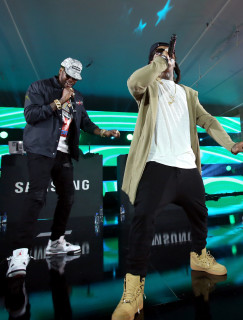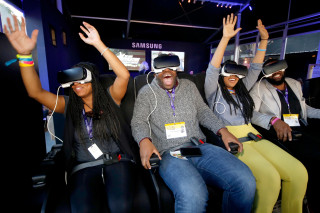Minutes after Public Enemy riles up the crowd of SXSW attendees at the Samsung Galaxy Life Fest to the tunes of “Fight the Power” and croons of Flavaaa Flaaav, Dallas Mavericks owner Mark Cuban leaves the VIP area and steps to the stage to play part-time emcee.
In a festival that has more headline acts than a newspaper, the party of the weekend is about to begin. Cuban introduces ColleGrove—the new superstar rap duo comprised of Lil Wayne and 2 Chainz. The performance will be televised on Jimmy Kimmel Live; the energy in downtown Austin’s makeshift venue is palpable. A sea of cell phones sits in the sky to document snippets of the show, surely to be replayed by each sober soul the next day.

This brave reporter unearths his iPhone at the competitor’s party and begins to document a few clips for the personal archives, too. That’s when Tim Baxter, president and chief operating officer of Samsung Electronics America, who just hours earlier gave an exclusive interview to [a]listdaily, suddenly stands next to me, and begins teasing the photo quality of my pictures.
Baxter is less than 24 hours removed from releasing the Galaxy S7 and is more than eager to show off some new features. He pleads that we take pictures from the same vantage point, standing side-by-side. I oblige, only to swing and miss three times before pointing out that the mushroom clouds emitted from Lil Wayne’s smoking paraphernalia were clouding my frame—not to mention my frame of mind. Baxter laughs, and the evening goes on when later, his point is further driven home when my selfie with Cuban looks like a shot from an ‘80s TV set.
The night continues when Wheezy pours a bottle of champagne over an S7 to showcase the phone’s new water-resistant features, just like the commercial. The proceedings are a proper homage to Austin’s “keep it weird” mantra.
Baxter and the rest of Samsung were not only in town for fun nights that also featured The Roots and Sia as part of the company’s first Galaxy Life Fest that celebrated the launch of the new Samsung Galaxy S7 and S7 edge devices. The electronics conglomerate unveiled a series of products and activations, but mainly made a strong statement that they’ve bet a sizable stack of chips for a pair of pocket aces they call virtual reality.
“We’re in virtual reality for two reasons: one, we’re an entertainment company. We create big televisions, mobile phones—this is an entertainment-consumption environment we’re living in, so it’s a big part of our business,” Baxter tells [a]listdaily. “The other reason is we think we have some unique technologies that are required for VR with the processors in phones, and our screens. Those two things are vital in the VR mobile space. That helped drive our thinking.”
Samsung made a statement by showing commitment to mobile VR ecosystem solutions the day they announced Gear VR—the undisputed highest-performance mobile VR, with the lowest-latency head tracking, and highest-performance applications with brands and top-tier developers building for the platform. Powered by Oculus, it introduced mass-affordable VR to people who may not have been fully aware of it. They’ve gone on to introduce a suite of substantial stuff, including Project Beyond, the Samsung Milk VR app—a VR content service exclusive to the Gear VR headset, and of course, Gear 360, the world’s first professional-grade automatic 3D virtual reality camera to quickly develop user-generated content. It’s designed to let consumers easily create, view and share their favorite experiences through video- and still-image content. User-generated content is the next big frontier, Baxter believes.

What has Samsung learned since the Gear VR Innovator Edition was launched a little over a year ago? That people really love VR experiences.
“That really helped give us great confidence and really helped propel us to go deep into VR,” Baxter says. “We understand the responsibility of moving virtual reality forward, and it’s in our best interests. Virtual reality is poised for great, great growth. I’m also a believer that sometimes we overestimate the short-term impact but underestimate the long-term impact. I think virtual reality is going to continue to grow.”
Baxter says he’s most excited in developing and stimulating the content ecosystem to cultivate the mass-market mobile VR space. Enter premium immersive experiences like the VR Coaster, a ride creation for Six Flags Parks, or LeBron James’ exclusive film series. Now, Samsung has over 650 titles available on Gear VR, including documentaries, animations, short films and original programming like Gone. The proof is in the pudding: VR-specific content can drive the market.
“You have to be able to demonstrate, and that’s why we brought out the Innovator Edition to prove the concept, show the promise, which then stimulates the content community. They know brands like Samsung are going to get in (VR) in a big way,” Baxter says. “It’s an example of helping the content community create more content.”
Baxter compares Samsung’s current VR climate to the one the company saw in the transition from analog to high-definition television, or from DVD to Blu-ray—when you’re creating a new format, or new category, and you’re one of the leaders, it’s more than selling a piece of it. Providing an extremely high-quality experience attracts developers and consumers, and that’s a self-reinforcing cycle. He’s quick to note Samsung has endless experience creating new markets, formats and technologies. They’re well aware they have to build the value chain. It’s in their best interests.
“Just think of where virtual reality has come in a little more than a year. We’re committed to this, and we believe in it,” Baxter says while remaining coy of sharing future announcements. “It’s ready for primetime.”
Follow Manouk Akopyan on Twitter @Manouk_Akopyan.




